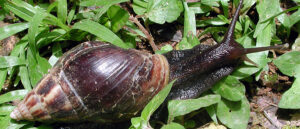
Many individuals believe that keeping large African land snails as pets is “destructive, invasive, harmful, and unlawful.” They have great destructive potential, are major agricultural pests, and are outlawed in the United States and certain other nations. However, they are legal as pets in certain other countries (although in some of these places it is illegal to release them or their eggs into the wild). They can also carry a parasite that can cause meningitis, though no cases have been reported in the United States (and infections with this parasite are usually linked to consumption of snail meat).
Are Giant African Land Snails Pets Or Pests?

The Giant African snail, which originated in East Africa, is now wreaking havoc on plants in many nations across the world. Some of its proliferation has been intentional, as people have brought these snails into their homes as novelty pets. Snails that escape can become ubiquitous in the right climate. Because exotic snails are prone to escaping and spreading. This causes issues for all kinds of flora and the Australian eco system, hence exotic snails from other countries, notably enormous African snails, are outlawed. They have been designated as National Priority Plant Pests, with the gigantic African snail topping the list. Because of its ravenous appetite. The enormous African snail would prey on over 500 plant species, including most vegetables, flowers, bananas, citrus, and the natural environment.
Snail Seizures: What is the Legal Status of Snails?
The Animal and Plant Health Inspection Service of the United States Department of Agriculture seized numerous huge African land snails (along with many eggs) in Wisconsin in late 2003 and early 2004. (APHIS). According to the Milwaukee Journal Sentinel Online (April 29, 2004), APHIS launched an inquiry after a pet retailer enquired about the legal status of huge snails as pets, and as a result, APHIS confiscated more than 100 snails from pet stores, private owners, and exotic pet swap meets. When numerous schools learned about the situation of these snails, they turned over their classroom pets and/or projects. So far, all snails discovered have been in captivity; none have been detected in the wild.
What Should You Do If You Own a Giant African Land Snail?

Please do not dispose of a big African land snail yourself, and do not, under any circumstances, release it into the wild. Contact your local APHIS office. Bringing big African land snails into the United States is unlawful and can result in severe fines. While ignorance of the law is not a good defense in most cases, in this case, officials have not charged anyone and are more concerned with keeping the snails contained rather from punishing those who kept them. The USDA’s top priorities right now are education about the risks of these snails and limiting the snail population, and authorities have been quoted as suggesting that anyone who obtained one of these snails while uninformed of the regulations will not be prosecuted if they contact officials.
It is unknown how these snails got to Wisconsin in the first place.
The USDA and APHIS consider these snails to be dangerous pests and are actively looking for enormous African land snails. According to APHIS, three of the snails were smuggled into Florida in the 1960s and later released. There were an estimated 18,000 of the critters in the wild within seven years, and it took ten years and more than a million dollars to eliminate them altogether. The emergence of large feral populations in the United States is a legitimate issue. Because the snail hibernates in cold temperatures, it could theoretically survive and reproduce in most parts of the United States.
Giant African land snails are not as dangerous as pet tigers and alligators, but their potential for ecological and economic damage is enormous. Assuming, or even hoping, that all owners would be accountable is insufficient. If all owners will research and obey the regulations governing unusual pets such as enormous African land snails, and never release pets into the wild, animals like these might be more widely accepted as good pets.
How To Identify Giant Land Snails?

Giant African snails are six to seven times the size of the average garden snail. They feature a unique conical shell that is frequently twice as long as it is wide. They have a long, narrow cone-shaped shell that is normally 5 to 10 cm long but can grow to be 20 cm long. They can be a variety of colors, but the majority are light brown with striped brown and magnolia bands. They lay batches of 200-500 yellow eggs around 5 mm across.
Conclusion
What do you think? Should Giant Land snails be considered pets or pests? Share your take with us in the comments section below. Cheers!
